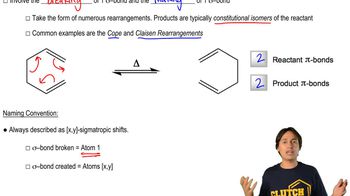a. Name the kind of sigmatropic rearrangement that occurs in each of the following reactions.
1.
2.
![Chemical structure illustrating a [5,5] sigmatropic rearrangement with a phenyl group and a diene.](https://static.studychannel-dev.pearsondev.tech/courses/organic-chemistry/thumbnails/30886d49-6415-4309-97db-2ac92f18960f)
 Verified step by step guidance
Verified step by step guidance Verified video answer for a similar problem:
Verified video answer for a similar problem:



 3:51m
3:51mMaster Definition of Sigmatropic Shifts with a bite sized video explanation from Johnny
Start learning